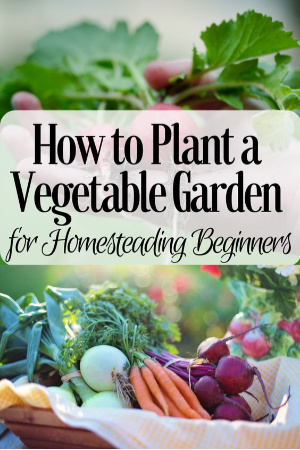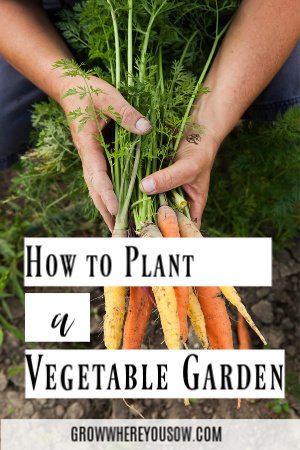How to plant a vegetable garden
Before moving onto the homestead, I had some gardening experience planting a vegetable garden and made some mistakes. Hindsight is 20-20 so I’m here to tell you how to get started on the right foot, right away.

Table of contents
From soil testing to seeds, a full run-down on how to plant the best vegetable garden for homesteading beginners.
The first step when planting a vegetable garden is a SOIL TEST!
If you haven’t had your soil tested and you know how to plant and grow a perfect vegetable garden then hats off to you! I’m not saying it’s impossible! Here in Florida, our “soil” is just sand. That means that we had to buy soil from an outside source. It was a huge mistake not to test the outside source.
The first truckload of soil we got was great! The second truckload, not so much. There were huge chunks of plastic and such in the soil. I should’ve never put in my gardens but I did.
Well, fast forward about 1.5 years and I think I’ve mended it all alright. My soil test came back normal, with a PERFECT pH! I had a better vegetable garden than I have had in a while but this last season was still rough.
I decided to plant cabbage, carrots, garlic, and greens and they were GREAT! So just get your soil tested so you know what you’re working with, what you need, and what you don’t need to start off. I also suggest calling your local county extension office and having someone explain exactly what the results mean. More on why in a moment!
Companion planting
Companion planting is when you plant one crop with another because it benefits the crop in some way. This could be pest control, pollination, providing habitat for beneficial creatures, maximizing the use of space, and/or increasing crop productivity.
For example, beans provide broccoli nitrogen. Beans give off loads of nitrogen and broccoli needs it.
I just recently started focusing more on companion planting in my vegetable garden, how could I not? After a season or two, I feel SO SILLY I didn’t start earlier! I grew the best carrots this year and the only reason I can think of why is because I planted them with garlic.
This Spring/Summer season I’m really going to focus on companion gardening. I really believe it is a crucial part of gardening. If you’re just starting, there are so many charts you can find online! Just Google “Companion Planting Charts”!
Nitrogen and more nitrogen
Okay, so I told you I’d explain why I think you should call your local county extension office once you had your test results to know how to plant a vegetable garden.
Here’s why. When I received my soil test back I thought everything was through the roof but the nitrogen. I didn’t exactly know what I was looking at although I read everything on the papers at least 3 times.
The head of the Master Gardener program told me everything was great! SLAP IN THE FACE. This means I just really stunk at vegetable gardening this last season…even though she told me the weather was just so wonky for most plants.
She explained to me that, when getting your soil tested, nitrogen is the hardest thing to test for because the nitrogen in your sample that you send gets less and less strong every day it’s in the bag.
This means there’s no real way to know how much nitrogen you have and
But remember, never add nitrogen to plants such as beans because they provide the soil with nitrogen. You can read a few ways to naturally add nitrogen here.
Quality seeds
When you’re learning how to plant a vegetable garden, it’s so important to understand that seeds matter. I buy all my seeds from Baker Creek Seeds and I’ve never been let down by the quality or time of shipping.
There are other really wonderful seed companies out there, too, so do your research and find what works in your garden. I’ve found that heirloom seeds are the best option for my garden and think everyone should grow some heirloom crops.
Starting with bad soil is the first unfortunate step, putting terrible seeds in great soil is sad, too. I’m not an affiliate of Baker Creek Seeds, I just love the company and their products. Who do you use? I’d love to hear from you down below! Good
How to plant a vegetable garden
Get a soil test, practice companion planting, use nitrogen and sow quality seeds and you’ll be right on your way to vegetable gardening. You can thrive on your homestead planting vegetables with a little tender, love and care.
Need more help gardening? Check out the Gardening & Sustainable Living Bundle! This bundle includes 21 eBooks, 7 courses, and 5 printable planners to help you grow gorgeous gardens and work towards s sustainable way of living.


Thanks for the guide, I have had several gardens, something always goes wrong!! Is there anyway to test your own soil? I’ve lived in the country for several years and blessed with a lil acreage, here in my part of Ky. My ground is some part red clay, slate rock, but my spot for the garden is good dirt, I’m very curious about planting vegeta bles that help each other. With this corona virus going around, I feel sure there will be more gardens this year!! Is there a site you recommend to get this info on and best times to start different things? Thank you and please stay safe TeresaTharp, Gravel Switch Ky
Hi Teresa! I always suggest getting a full soil test done through your county extension office. I have seen DIY Soil Tests on Pinterest but I can’t speak to if they’re accurate or not. It could be worth the try! I AGREE with you on there being more gardens during the coronavirus – I sure hope people take to the land a little more. For what to plant when depending on your location, I would say to start with The Old Farmer’s Almanac! https://www.almanac.com/gardening/planting-calendar
Best of luck to you in all your endeavors. Feel free to keep me updated! Stay healthy and thanks for stopping by!